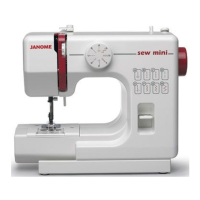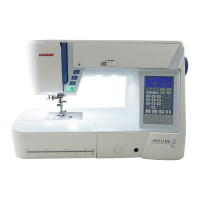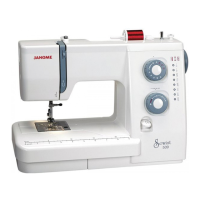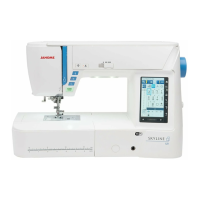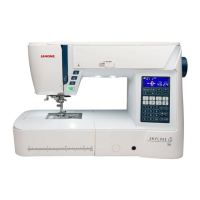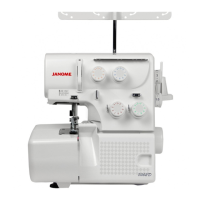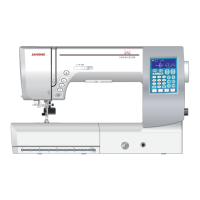Do you have a question about the Janome SW-2018E and is the answer not in the manual?
Instructions to reduce the risk of electric shock.
Instructions to reduce risk of burns, fire, electric shock, or injury.
Recommendation to retain the safety instructions for future reference.
Essential practices and actions to avoid during machine operation.
Detailed list and illustration of the sewing machine's main parts.
Description of the compartment for storing presser feet and accessories.
Information on attaching and using the extension table and accessory box.
Steps for safely connecting the sewing machine to an electrical power source.
How to use the foot pedal and speed control for sewing.
Details on the function and replacement of the sewing machine light.
How to set the pressure dial for different fabric types.
Instructions for raising and lowering the feed dogs for specific sewing tasks.
Procedure for attaching and detaching the presser foot.
Step-by-step guide for replacing a sewing machine needle.
Recommendations for thread and needle selection based on fabric type.
Instructions for winding thread onto the bobbin using the bobbin winder.
Guide for threading the bobbin winder mechanism correctly.
Steps for correctly inserting the wound bobbin into the bobbin case.
Comprehensive guide to threading the sewing machine from spool to needle.
Procedure for bringing the bobbin thread up to the needle area.
How to adjust thread tension for balanced stitches in straight seams.
Using the dial to choose different stitch patterns.
Setting stitch length and zigzag width for desired results.
Adjusting needle position for specific sewing tasks.
Instructions for performing straight stitch sewing on various fabrics.
How to pivot fabric to change sewing direction mid-stitch.
Techniques for sewing through thick or heavy materials.
Using the zigzag stitch for overcasting, applique, and buttons.
How to use stitches to prevent fabric fraying and finish raw edges.
Using the overedge stitch to prevent fabric rolling and stop raveling.
Guidance for sewing the tricot stitch, focusing on edge alignment.
Using a durable stitch for reinforcing seams in high-stress areas.
Sewing a narrow stretch stitch to prevent puckering on knits.
Steps for creating standard buttonholes on garments.
Instructions for sewing buttonholes with a decorative cord for reinforcement.
Method for attaching buttons with a shank for durability.
Step-by-step process for sewing zippers into garments.
Creating an invisible hem using a blind stitch technique.
How to sew a neat, narrow rolled hem on fabrics.
Using satin stitch for decorative effects, adjusting thread tension.
Sewing with pre-set stretch stitch patterns for elastic fabrics.
Fine-tuning stitch balance for consistent stretch stitch results.
Creating decorative smocking by sewing parallel gathering stitches.
Using the quilting guide for stitching straight lines in quilting projects.
Creating decorative pin tucks by folding and guiding fabric.
Sewing a decorative shell tuck stitch along fabric edges.
Creating a decorative fagoting stitch by joining fabric edges.
Techniques for applying fabric pieces and creating patchwork designs.
Instructions for cleaning the bobbin holder and hook race for optimal performance.
Detailed cleaning of the hook race and replacing the bobbin holder.
Diagnosing and resolving issues with machine noise and smooth operation.
Troubleshooting common causes for the needle thread breaking.
Identifying and fixing problems causing the bobbin thread to break.
Common reasons for sewing machine needles breaking and solutions.
Resolving skipped stitches by checking needle, thread, and tension.
Addressing puckering in seams by adjusting tension, needle, or stitches.
Resolving issues where stitches form loops underneath the fabric.
Diagnosing and fixing issues with the cloth not feeding smoothly.
Common reasons why the sewing machine may not operate.
Correcting buttonhole stitches that are not balanced or even.
| Type | Electronic |
|---|---|
| Stitch Count | 18 |
| Maximum Stitch Width | 5 mm |
| Maximum Stitch Length | 4 mm |
| LCD Screen | No |
| Built-in Needle Threader | Yes |
| Drop Feed | Yes |
| Free Arm | Yes |
| Built-in Stitches | 18 |
| Bobbin Type | Top drop-in |

